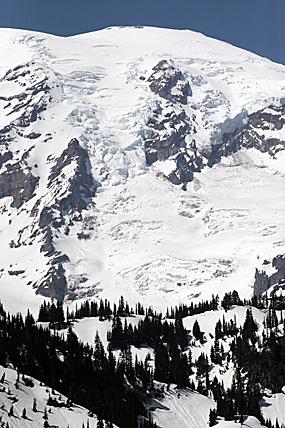It is one of the oldest parks in the National Park System, having been established on this date in 1899, and yet ... there's a decidedly new face to Mount Rainier National Park.
Fall storms in 2006 and again this past year reorganized some of the park's landscape, the old Jackson Visitor Center at Paradise has been replaced by the new Jackson Visitor Center, and the venerable Paradise Inn has regained some of its youthful sturdiness following a two-year renovation that addressed not just foundation woes but also electrical needs.
Some might say the potent fall storms that have been descending on Mount Rainier in recent years are the calling cards of climate change. Indeed, as home to the greatest single-peak glacial system in the United States -- 25 (or 26, depending on who's counting) glaciers with a combined 35 square miles of ice -- Mount Rainier is a good place to monitor climate change, particularly in terms of its impact on glaciers.
For a cool interactive map that shows that physical location of the mountain's glaciers and provides some general information on some of them, check out this site. To get an idea of how the glaciers have retreated over the last century, check out this page and click on the years 1994, 1976, 1913, and 1896 to see the difference in the rivers of ice.
Of course, Mount Rainier isn't all about glaciers. Perhaps more startling to first-time visitors to the park is the fact they they're standing atop one of the Northwest's dormant volcanoes, one that still has a fairly strong pulse.
According to Park Service geologists, "about 5,600 years ago the summit and northeast face of Mount Rainier fell away in a massive landslide accompanied by volcanic explosions. The Osceola Mudflow, a towering wall of mud and rock, thundered down the White River Valley where it deposited 600' of debris eventually reaching the Puget Sound."
Will such a massive event happen again in our lifetime? It's hard to say. But there could be lesser volcanic or geologic events. Back in the summer of 2001 a mudflow erupted when warm temperatures increased melting of the Kautz Glacier in the park. The meltwater saturated loose glacial debris, resulting in a small debris flow along Van Trump Creeks. Mud and debris covered trees and trails.
Against that natural history, don't get the idea that Mount Rainier should only attract curious geologists. This 235,625-acre park is a giant in the National Park System. Nearly most of the park -- 228,480 acres -- is wilderness, which opens up countless possibilities for backcountry travel. Too, the Paradise and Sunrise areas offer easy access onto the snow-covered flanks of Rainier, making snowball fights in July and August one of the must-do activities.
There are wildflower meadows to admire and great day hikes that lead you off into the landscape, whether it's the ripples in Rainier's flanks or the old-growth forests down near Ohanapecosh in the southeastern corner of the park.
The temperate rain forest setting in the northwestern corner of the park is eye-opening for folks accustomed to either the hardwood forests of the East Coast, the parched grasslands of the nation's interior, or the arid, canyon-cut landscapes of the Southwest. And if you've got the time and the trails are in good condition, you can even walk up to the snout of the Carbon Glacier.
And while the Paradise Inn offers a wonderful place to hang your hat or rest your hiking staff at day's end, don't overlook the National Park Inn and its 25 rooms at Longmire. This is a much, much smaller, and so decidedly quieter, setting than the more famous inn. But that makes it a touch more charming.
And while the Paradise Inn won't open until May, the National Park Inn is open year-round, so if you've got the time you can still manage some snowshoeing or cross-country skiing in the park this winter without the need to leave come sundown.




Add comment